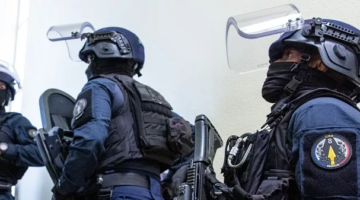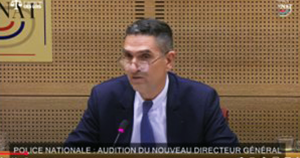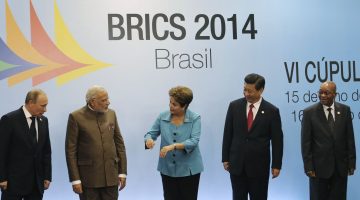By Kenneth Maxwell , Harvard Professor- Brazil is facing the perfect storm. There is political gridlock in Brasília. Both in the Congress and in the Presidential Palace.
On 19 March, Angeli, a cartoonist of the “Folha de São Paulo”, which is Brazil’s largest newspaper, portrayed President Dilma Rousseff, who was only re-elected to a second term in October last year, as a tiny figure sitting in a huge armchair, under the headline “Little Miss Sunshine” (Pequena Miss Sunshine).
Only three months into her second term, Dilma Rousseff’s popularity, according to the most recent “DataFolha” opinion poll, was one of the lowest for a Brazilian president in recent Brazil history. She had a 62% disapproval rating nationwide. But in the south of Brazil in places it reached 75%, and even in the northeast, where her support was stronger in October, it stood at 55%.
The problems facing Brazil are cumulative.
Expanding allegations of corruption which encompass the private and state business sectors as well as leading politicians and political parties.
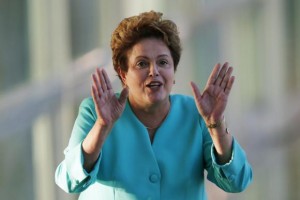
Brazil’s President Dilma Rousseff reacts during a news conference at the Alvorada Palace in Brasilia September 8, 2014. REUTERS/Ueslei Marcelino
Domestic economic woes from high inflation, diminished growth prospects, increasing unemployment, the first primary budget deficit in over a decade, and the 39% decline in the value of the Brazilian currency (the Real, R$) against the US dollar over the past two years.
International damage to Brazil’s foreign relations where Dilma’s government has set much store on engagement with the BRICS (Brazil, Russia, India, China and South Africa), as well as with Venezuela, Argentina and Bolivia in South America.
And legal entanglements with foreign tax and oversight authorities as a result of the multiple international linkages of Brazil’s various corruption scandals
These multiple scandals involve not only the Workers Party (PT), but also those in São Paulo, a state long run by the main opposition party, the Brazilian Social Democratic Party (PSDB), where bribery and price fixing have emerged involving foreign corporations (the French conglomerate Alstom and the German firm of Siemens) in contracts for the Metro transportation system.
The problems are complicated by challenges to the credibility of leading media families and individual journalists which have resulted from the on going revelations of Swiss Leaks about secret bank accounts held by Brazilians at HSBC Private Bank in Switzerland.
Not all of these secret accounts involve any illegal activity.
But some apparently involve large sums secretly laundered by individuals hiding monies obtained from various kickback schemes involving Petrobras.
All of which contributes to the debilitating and widespread anger on the streets at the daily revelations of the pervasive corruption by those in power.
Any one of these crises would be bad enough.
But coming together they pose serious questions about the stability of the democratic regime established thirty years ago.
And worse.
They pose serious questions about the capability, and the capacity, of the Brazilian political establishment, to deal with any of these multiple challenges effectively.
In fact the crisis of governance is the most serious that Brazil has faced since military rule ended in 1985.
March 15 was the date in the Roman calendar that marked the “Ides of March.” It was the day on which Julius Cesar was assassinated in the Roman Senate, and saw the transition from the Republic to the Empire. March 15 also marks 30 years since the first civilian was installed in the presidency after two decades of military rule.
And it was the day on which over a million Brazilians last Sunday took to the streets throughout the country to protest against corruption.
Yet the solutions proposed were diffuse and contradictory.
Some wanted the impeachment of recently re-elected president Dilma Rousseff; others called for a return to military rule; others beat their pots and pans in a eerie rerun of the marches of “Families for God and for freedom” that preceded the Brazilian military coup in 1964.
But how, and what, and who, would achieve any of these objectives?
It is likely that the major party in Congress, the Party of the Brazilian Democratic Movement (PMDB), and until now a key component of the congressional coalition that supports Dilma’s government, will prefer a severely weakened president to a replacement.
But this is not a foregone conclusion.
Dilma Rousseff has not been consulting Michel Temer, her Vice-President in recent weeks. And Michel Temer, of Lebanese origin, is a former long-term PMDB congressman from São Paulo, and is the next in the line of succession to Dilma Rousseff. He is a former six term congressman, and has on three occasions served as president of the lower house of congress, and perhaps best known to most Brazilians because of his beautiful wife, Marcela Temer, who is 42 years his junior.
After Michel Temer in the line of succession comes the president of the lower house of Congress, Eduardo Cunha, a conservative evangelical Christian from Rio de Janeiro. And after him the president of the senate, Renan Calheiros, from Alagoas. But both Cunha and Calheiros have been involved in dubious activities in the past, and both are on the list of those accused of involvement in the Petrobras kickback scheme.
The demonstrations last Sunday were largest in south of Brazil, and the most covered by the media took place along the Avenida Paulista in Sao Paulo and on the Avenida Altantica in Rio de Janeiro. They were composed largely by the already disillusioned middle class, made up of those who voted overwhelmingly against Dilma Rousseff last October.
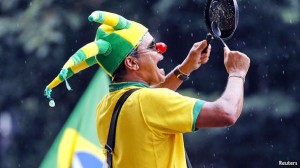
But demonstrations had also taken place the previous Friday in support of the scandal plagued state petroleum corporation Petrobas, that is at the centre of the current corruption scandal, as well as in favor of Dilma Rousseff’s Worker’s Party (PT). These were much smaller gatherings than the anti-Dilma demonstrations on Sunday, but were no less determine.
And already “social” movements in the countryside and in the cities, where the MST, the movement “sem terra” (“without land”), and the MTST, the movement “sem teto” (without roof), both close to the PT, have been agitating and blocking roads, and are adamantly opposed to the economic policies proposed to curb Brazil budget deficits by Joaquim Levy, Dilma Rousseff’s new finance minister.
The potential for confrontation is growing by the day since each side increasingly demonizes their opponents.
President Dilma Rousseff was re-elected in October by a very slender margin, and the election revealed a country deeply split on regional and class lines. The south supported the opposition led by senator Aécio Neves, who was the candidate for the PSDB. Even though he lost, significantly, in his home state of Minas Gerais, he was supported by a formidable array of advisers, including Armínio Fraga, a former Central Bank President, a fund manager who previously worked in New York for George Soros. Aécio Neves is the maternal grandson of the Tancredo Neves, who was the first civilian to be indirectly elected president of Brazil by an electoral college on January 15, 1985.
Tancredo Neves was 74 at the time, He was a politician highly skilled in the art of the possible. And he was a steadfast democrat and a firm opponent of military rule. He was able to weave together a formidable civilian alliance. But in a sad twist of misfortune he did not assume office. He became gravely ill after a extensive world tour and died on April 21, 1985. José Sarney, his vice-presidential running mate (and who came from a splinter of the party which had supported the military regime) took office as acting president, and became the president of Brazil after Tancredo’s death.
Nevertheless, despite many alarms and false starts, democracy prevailed.
And during the past two decades was consolidated under the two term presidency of Fernando Henrique Cardoso for the PSDB, (1995-2003), followed by two terms under Presidency Lula of the PT (2003-2011), who was succeed by his protogee, Dilma Rousseff of the PT in 2011.
The opposition to the PT government is stronger in Sao Paulo, which is the financial, business, and industrial heart of Brazil, and where on Sunday the calls are loudest her impeachment.
One democratically elected president of Brazil, Fernando Collor, left office under the threat of impeachment in 1992 (in a scandal that involved allegations of corruption).
But it is not at all straight forward that a similar move would succeed today.
Even if it can be proved that Dilma Rousseff was involved in, or knew about, the corruption at Petrobras.
Though the protestors on the streets of São Paulo last Sunday clearly believe she did. Dilma Rousseff was after all the chair of the its board of directors of Petrobras from 2003 until 2010, and she was also the chief of staff of President Lula da Silva, when the corruption at Petrobras was apparently rampant.
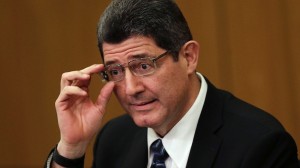
Joaquim Levy, Brazilian Finance Minister. CreditL Folha
Brazil’s Federal Police and independent public prosecutors have been critical players in the crisis. Operation “Lava Jato” (operation “car wash”) has already placed many businessmen and former Petrobras officials in jail, and are perusing international links in Switzerland and the United States, among other non-Brazilian jurisdictions, to recover laundered money, and to find hidden bank accounts.
The Brazilian attorney-general has sent a list of politicians allegedly involved to the supreme court.
Most remarkable has been the arrest and preventative detention of executives at the Federal Police Headquarters in Curitiba of some of Brazil’s largest building and construction companies for paying bribes in exchange for contracts with Petrobras between 2003 and 2014.
This is the first time such arrests have taken place in Brazil. And they involve executives of Camargo e Corrêa, OAS, Odebrecht, UTC, Queiroz Galvão, Mendez Junior, Galvão Engenharia. The sum involved is said to be US$22 billion.
The Swiss attorney general announced this week that he had frozen US$400 million in suspected Brazilian accounts. SBM offshore NV, a Dutch supplier of floating oil platforms signed a memorandum of understanding to cooperate with Brazilian authorities investigating companies for corrupt contracts with Petrobras. SBM had previously agreed with Netherland’s prosecutors to pay US$240 million to settled alleged improper payments to sales agents for companies, including Petrobras between 2007 and 2011.
The US Security and Exchange Commission is also investigating and several law suits have be filed by investors.
All of which makes the job of “market friendly” Joaquim Levy, Brazil’s new finance minister, difficult indeed.
Senate president Renan Calheiros of the PMDB, rejected a presidential decree to raise payroll taxes, apparently in retaliation for not clearing his name of the list in the corruption probe. Which sent Brazil’s currency to a 12 year low against the dollar. Eduardo Cunha, president of the lower house, also of the PMDB, then forced Dilma Rousseff to sack her education minister, the former governor of Ceará, Cid Gomes (he had only been appointed on January 1st), after he spoke at a tumultuous session of the congress.
He had accused the members of the lower house of being a bunch of “swindlers” (achacados), in response to which, an angry member of the house in a tumultuous session called him a “clown”. But on YouTube one observer said that Cid Gomes was the lucky one. He had in fact escaped the “Sinking of the Titanic.”




